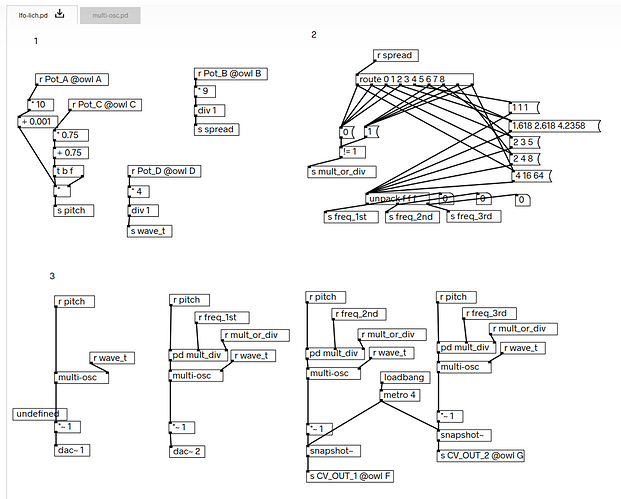The docs were very helpful, but I think I’m missing something.
My patch behaves as expected if I use faust2jack - I can see that the rate of output from F, G, B5 and B6 are controlled by my sliders.
But, on the device, only outputs F and G are producing signals.
import("stdfaust.lib");
// Slider for LFO1 rate (in Hz)
lfo1_rate = hslider("LFO1 Rate[OWL:A]", 1, 0.01, 10, 0.01);
lfo1_out = hbargraph("LFO1>[OWL:F]", 0, 1);
// Slider for LFO2 rate (in Hz)
lfo2_rate = hslider("LFO2 Rate[OWL:B]", 1, 0.01, 10, 0.01);
lfo2_out = hbargraph("LFO2>[OWL:G]", 0, 1);
// Slider for LFO3 rate (in Hz)
lfo3_rate = hslider("LFO3 Rate[OWL:C]", 1, 0.01, 10, 0.01);
lfo3_out = hbargraph("LFO3>[OWL:B5]", 0, 1);
// Slider for LFO4 rate (in Hz)
lfo4_rate = hslider("LFO4 Rate[OWL:D]", 1, 0.01, 10, 0.01);
lfo4_out = hbargraph("LFO4>[OWL:B6]", 0, 1);
// LFO function
sinusLFO(rate) = os.osc(rate) : si.smoo;
// Oscillators
lfo1 = sinusLFO(lfo1_rate) : si.smoo : *(0.5) : si.smoo :> lfo1_out;
lfo2 = sinusLFO(lfo2_rate) : si.smoo : *(0.5) : si.smoo :> lfo2_out;
lfo3 = sinusLFO(lfo3_rate) : si.smoo : *(0.5) : si.smoo :> lfo3_out;
lfo4 = sinusLFO(lfo4_rate) : si.smoo : *(0.5) : si.smoo :> lfo4_out;
// Process function with parallel LFOs
process = lfo1, lfo2, lfo3, lfo4;
Is there something other than hbargraph that I should use for B5 and B6?
